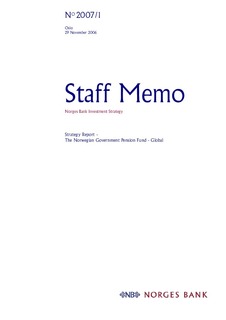| dc.description.abstract | Our report on “Long term market outlook” discussed the future market conditions both in the bond and equity markets, where the Pension Fund is currently invested, and in alternative asset classes, where the Fund may invest in the future. Here we summarise the findings and employ a simulation modelling framework to determine how changes in the investment strategy can be expected to affect the return distribution for the entire portfolio. We are looking both at the expected return and at different measures of risk exposure. The basic assumptions used in the modelling exercise are presented in section 1 below. We provide numerical details on the macroeconomic scenarios introduced in the Market Report, and specify the covariance matrices that will be assumed in each scenario. In section 2 we consider the equity/bond ratio in the existing benchmark portfolio, and the regional weightings within the equity and bond benchmarks. This analysis essentially confirms the conclusions from our 2005 Strategy Report. In section 3 we consider two market segments that are not currently part of the equity or bond benchmark. The small cap segment in the equity markets is the largest segment of listed markets outside the benchmark. We believe that the diversification benefits outweighs the operational burdens and recommend that small cap should now be included in the equity benchmark. The high yield segment of the bond markets is much smaller and heavily biased towards USD issues. But the expected return looks attractive, even taking the risk into account. We thus believe that the Fund should be invested in this segment. Replicating the Lehman High Yield index may on the other hand be a bad idea, because many of the papers in the index are difficult or impossible to buy, and because pricing may not always reflect risk in a reasonable way. We therefore do not recommend including the high yield segment in the bond benchmark. In section 4 we consider new asset classes. Real estate is the largest asset class where the Fund is currently not invested. We believe that real estate investments will provide attractive diversification benefits in the portfolio and recommend that it be included in the Fund’s investment strategy. The size of the market limits the exposure the Fund can realistically obtain, however. Infrastructure investments have very similar characteristics to real estate, but the market is so far substantially smaller. We are proposing a common allocation to these two asset classes, with a strategic target of 10 percent of the total Fund. This is in line with other large investment funds, but we realise that this target will not be reached in the first few years. The Fund shall need to set up a new investment organisation and gradually build its real estate and infrastructure portfolios. Private equity is another asset class commonly included in the strategic allocations of large funds. We believe that returns on private equity are highly correlated with returns in the listed equity markets, and that the diversification benefits are limited. Furthermore, we do not find any evidence that an average investor can expect higher returns in the private equity markets. Private equity consequently looks only moderately attractive in the modelling exercise. We still recommend a strategic target of 5 percent of the Fund invested in this asset class. The reason is that returns vary substantially between managers (“leading partners”) and that the differences tend to be persistent. A large investor such as the Pension Fund has a better probability of identifying and getting access to above average quality managers, and will then have a fair possibility of earning an excess return. | nb_NO |

